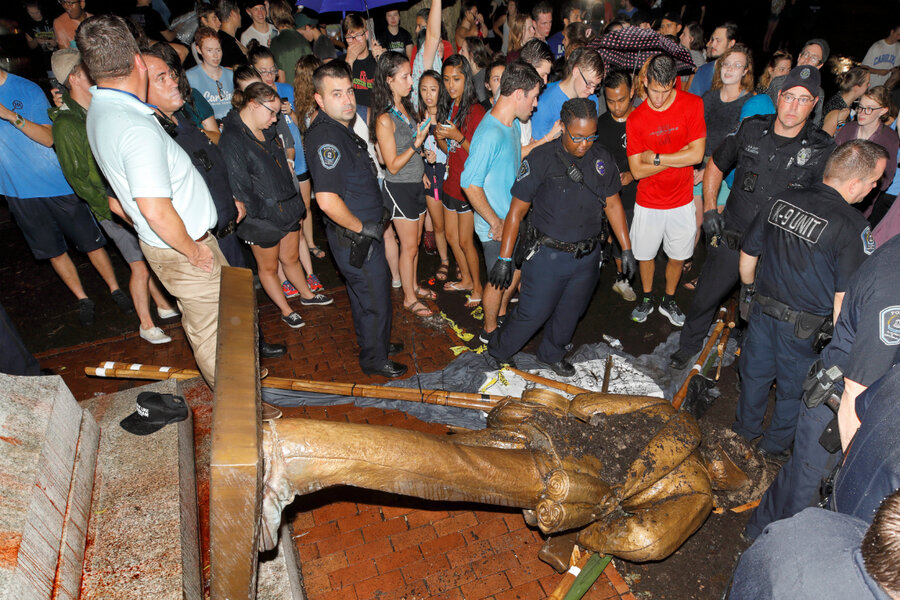Student protesters tear down UNC's Confederate statue
Loading...
| Chapel Hill, N.C.
A Confederate statue in the heart of North Carolina's flagship university was toppled Monday night during a rally by hundreds of protesters who decried the memorial known as "Silent Sam" as a symbol of racist heritage.
The bronze figure of a southern soldier atop a tall stone pedestal, erected by the United Daughters of the Confederacy in 1913, had been under constant police surveillance after being vandalized in recent months, costing the university hundreds of thousands of dollars.
Protesters appeared to outwit officers by splitting into two groups. Most marched away from the statue while a smaller group surrounded it with banners on bamboo poles, concealing efforts to tie a rope or cable around it. Then the groups converged and yanked it down, according to videos.
Once the bronze form was toppled, Silent Sam's face down in the dirt, demonstrators kicked it and cheered, chanting "Tar Heels!" and "Whose Campus? Our Campus!" as passing cars honked in approval. It was later covered by a tarp and then taken away.
Many students, faculty, and alumni had called the statue a racist image and asked officials to take it down. Others argued that it should remain as a tribute to fallen ancestors.
Protesters responded to the assertion that the statue wasn't a symbol of white power by reading from its 1913 dedication speech, by tobacco magnate Julian Carr, which praises Confederate veterans for terrorizing former slaves and making sure "the purest strain of the Anglo Saxon is to be found in the 13 Southern States."
University of North Carolina at Chapel Hill leaders including Chancellor Carol Folt had previously said state law prevented the school from removing it.
The pedestal still stands, with its bronze reliefs of an angel encouraging students to abandon their studies and fight for the South.
But the empty space where the soldier had stood for more than a century "is pretty breathtaking," said Manuel Ricardo, a freshman who is African-American. "I think most people here are happy. I'm ecstatic."
Junior Ian Goodson said he came out after he heard the statue fell because he wanted to see history.
"It's a significant event for UNC," he said. And while he doesn't agree with what the Confederacy stood for, he understands that some saw the statue as an important memorial.
Asked whether he's glad the statue came down, he said: "I was always kind of torn."
North Carolina ranks among the handful of Southern states with the most Confederate monuments, and has been a focal point in the national debate over them following a deadly white nationalist protest a year ago in Charlottesville, Va.
Protests over the UNC statue flared in the past year, and another Confederate monument in nearby Durham, N.C., was torn down shortly after the Virginia protest.
Democratic Gov. Roy Cooper had called for removing Silent Sam and other rebel symbols on public land. A state historic panel is set to meet this week to debate Governor Cooper's request to remove other Confederate monuments at the state Capitol.
Still the governor issued a statement on Twitter on Monday night arguing the protesters took the wrong approach.
"The Governor understands that many people are frustrated by the pace of change and he shares their frustration, but violent destruction of public property has no place in our communities," said the tweet from his official account.
UNC police referred all questions to the university's media relations department, which issued a statement Monday night.
"Tonight's actions were dangerous, and we are very fortunate that no one was injured. We are investigating the vandalism and assessing the full extent of the damage," the university said in a tweet.
This article was reported by The Associated Press.







